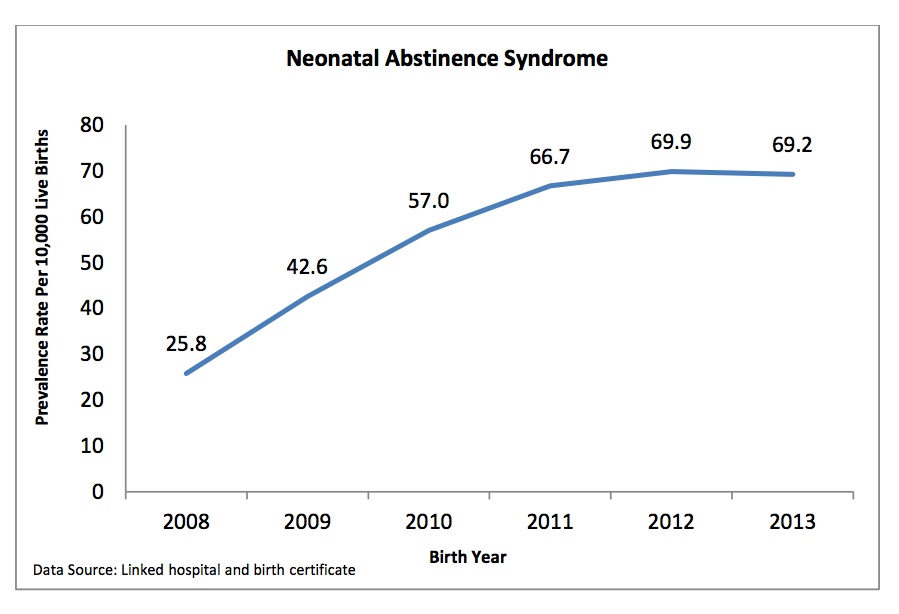PAINDEMIC Babies Withdrawing From Opioids!

It should not come as a huge surprise that a larger percentage of our American newborns are suffering the consequences of a rising trend in opioid use and abuse related to the American PAINDEMIC. More and more babies are suffering withdrawal effects after birth due to their mothers using licit or illicit drugs during pregnancy, such as hydrocodone, oxycodone, and heroin. Some of the withdrawal effects include:
- Poor feeding
- Irritability
- Hyperactive reflexes
- Excessive crying
- Tremors
- Seizures
- Sweating
- Vomiting
- Fever
- Diarrhea
These effects make up what is called the neonatal abstinence syndrome (NAS). Depending on the drug used by the mother during pregnancy, the withdrawal effects can begin up to three days after birth. The abrupt discontinuation of the drug from the mother’s blood supply can be incredibly uncomfortable for the newborn and may require re-administering a similar drug to the newborn and weaning slowly to avoid severe withdrawal effects.
The rise in neonatal abstinence syndrome (NAS) has been noted by many states, including Florida. The graph below shows how an average of 25.8 of every 10,000 live births were born with NAS, but in only five years that average rate had risen to 69.2 for every 10,000 live births.

Prevalence Rates of Neonatal Abstinence Syndrome in Florida Per 10,000 Live Births, 2008-2013. Source: Neonatal Abstinence Syndrome Data Summary: Maternal Characteristics Among Live Births From 2011 Through 2013. Florida Health. (March 2015) http://health.usf.edu/NR/rdonlyres/B74F2943-B3C4-42FD-A889-61FEB381FD64/50016/NeonatalAbstinenceSyndromeDataSummary20112013.pdf
It is interesting to note that in 2007 the United States consumed over 99% of the world’s supply of hydrocodone and 83% of the world’s supply of oxycodone. Whether the medication goes to the intended user or is diverted inappropriately to other individuals, there has been a quadrupling of overdose deaths and with little improvement of the over 100 million Americans suffering from chronic pain. Yet, these drugs are being prescribed for pregnant women and ultimately putting their own babies at risk, especially when used for longer periods of time or with higher doses.
Aside from tolerance to the drug and other known side effects, adults who consume opioids acquire physical changes in the brain which may not return to their previous appearances after discontinuation of the opioids. Moreover, there is still little evidence of the benefits outweighing the risks for opioids used for chronic, non-cancer pain. It makes one wonder why the medical system or mothers would subject the next generation to such potent drugs in the midst of the fetus rapidly developing its own nervous system?
The PAINDEMIC of over-utilizing medications and procedures for chronic pain is creating more problems including extending to the next generation. If we really want to avoid altering the vulnerable fetus’ nervous system, then it seems most prudent to avoid opioids in pregnancy and support healthier, non-drug approaches to decrease pain and suffering of pregnant women.
SOURCES:
Neonatal Abstinence Syndrome Data Summary: Maternal Characteristics Among Live Births From 2011 Through 2013. Florida Health. (March 2015) http://health.usf.edu/NR/rdonlyres/B74F2943-B3C4-42FD-A889-61FEB381FD64/50016/NeonatalAbstinenceSyndromeDataSummary20112013.pdf
Report of the International Narcotics Control Board for 2008. http://books.google.com/books?id=7iDhYnsYaocC&pg=PA20#v=onepage&q&f=false
IOM (Institute of Medicine). 2011. Relieving Pain in America: A Blueprint for Transforming Prevention, Care, Education, and Research. Washington, DC: The National Academies Press.
Jarred W. Younger et al, “Prescription Opioid Analgesics Rapidly Change the Human Brain,” Pain 152, no. 8 (2011): 1803-1810. doi:10.1016/j.pain.2011.03.028

